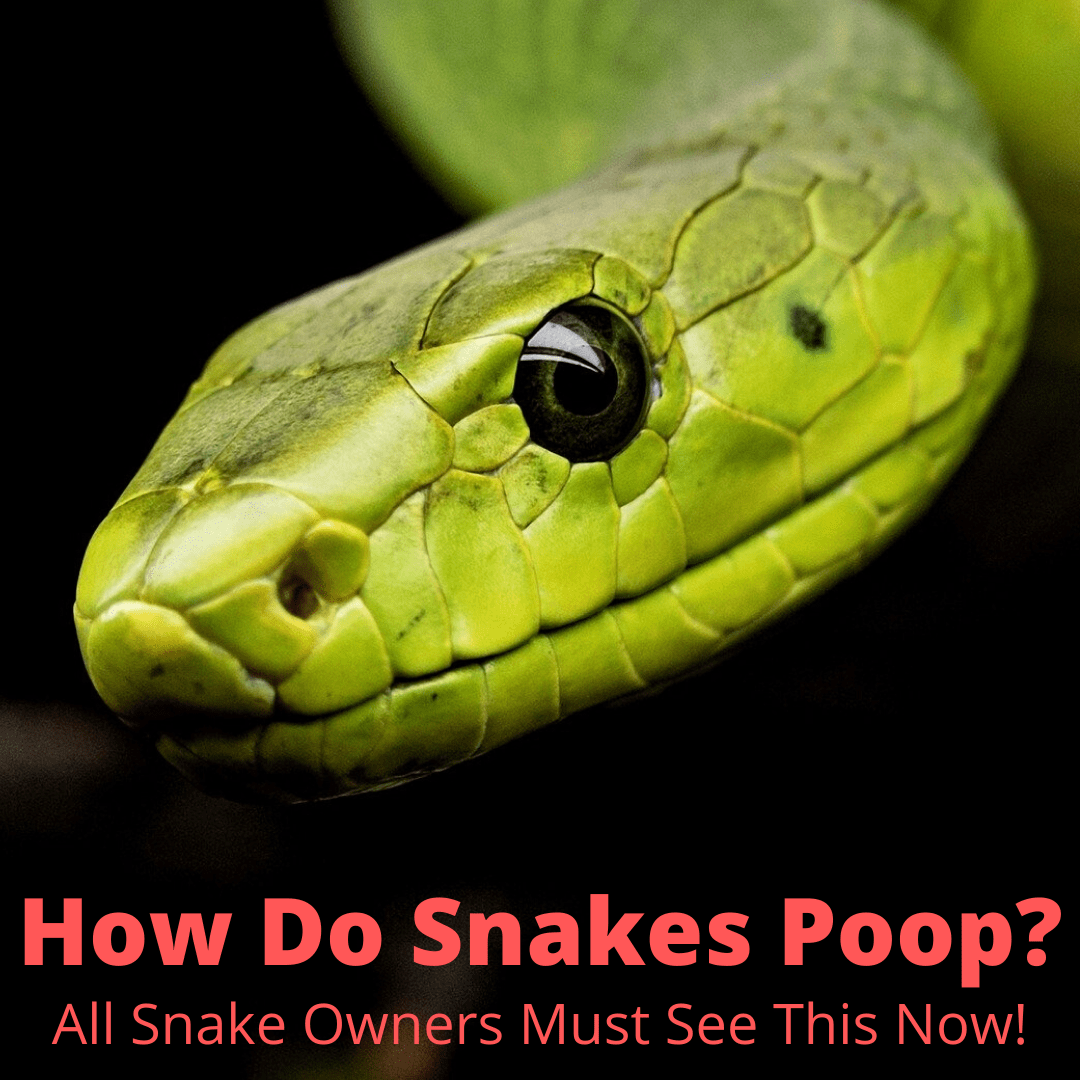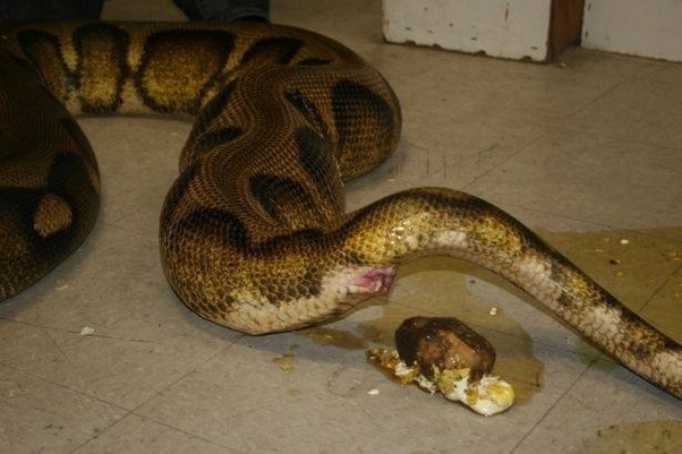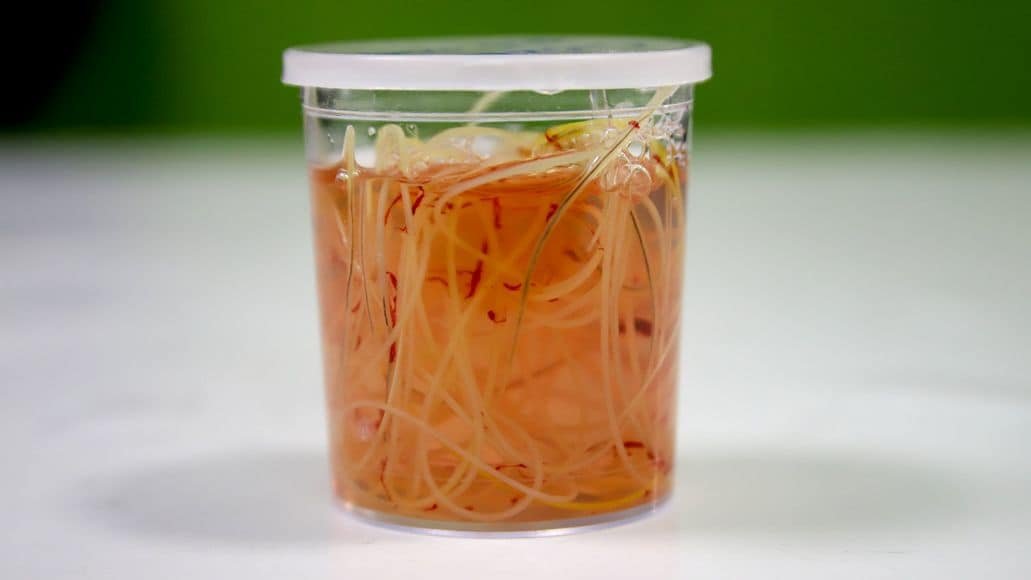
Well, differently from us anyway.
They digest food the same way we do. But how do snakes poop?
They poop like birds!
That means the poop and pee out of the same opening, which is called the cloaca. It is located at the base of the snake’s tail.
Since snakes excrete both solid and liquid waste from the same place, their poop can look a little slimy.
Seriously.
Watch the video below. It’s pretty disgusting.
You know what else is disgusting? More details! But let’s dig a little deeper anyway (unfortunate choice of words, I know…).
Table of Contents
How Do Snakes Poop?
Snakes tend to eat very infrequently compared to most mammals. Some larger snakes can go months without eating, depending on the size of their last meal.
As you would expect, they also evacuate solid waste less frequently. A snake’s gastrointestinal tract forces the feces out of the body.
They do not have to posture like a dog or cat normally do. They usually either sit still while defecating, or they slowly move their tails back and forth.
How Often Do Snakes Poop?
Most snakes take a few days to digest a meal. If you fed on a Monday, then it would be perfectly normal not to see any fecal matter until Thursday or even Friday.
Heat also plays a role, because snakes are ectothermic. This means they do not regulate their own body temperature internally as mammals do.
It is important to keep them at a temperature suitable for their specific species using heat bulbs or heat mats. If the ambient temperature is too cold, then a snake’s metabolism will slow down.
When this happens, your snake may not poop at all, and may even stop feeding. If you are worried that your snake is not pooping normally, check the temperature of its enclosure and increase it temperature a few degrees. This will warm your snake up some and increase its metabolism, making it poop more frequently.
If you are worried that your snake is not pooping enough, take it to your regular exotic veterinarian. They will take radiographs of your snake to make sure that there is no impaction. Snakes housed on sand are very prone to impactions. Warm water soaks help increase gastric motility and help your snake poop.
What Does Snake Poop Look Like?
Snake poop looks like most other animals as far as size and shape go. It can look slimier than most since it exits the body together with urine.
There can be white flecks throughout or it can have a white cap on the end. These white spots are urea caps. Urea is waste produced by the snake’s kidneys. It is the snake’s urine, but in a more solid form than mammals. Snake poop may even contain fur, especially if they are eating mice and rats.
Does Snake Poop Smell?
Snake poop can smell extremely foul. They eat a protein-rich diet which tends to make for more rancid poop than that of herbivores. With good husbandry and cage cleaning habits most, people don’t notice much odor at all. Fecal matter can build up in the cage, and if not cleaned routinely, will be more noticeable.

Regular fecal matter should not be confused with snake musk. Musk comes from a cloacal scent gland and is usually accompanied by urine and poop to create an extremely foul odor.
Overhandling and stress are triggers for snakes to release musk, and it can be very difficult to wash off the odor.
What To Do If My Snake’s Poop Is Not Normal?
If your snake’s poop isn’t normal it is best to have it examined by an exotic veterinarian. You should bring a fresh stool sample to your snake’s appointment for testing. It can be very difficult for a veterinarian to get a sample from your snake, so it is recommended to wait until you can get one at home.
The veterinarian will examine the feces under a microscope for parasites. If they find any parasites, then they will administer your snake the appropriate de-wormer based on what parasites are present. Most snakes eat mice or rats, which can be infected with parasites.
Routine visits to your veterinarian are a good idea to help keep your pet healthy. Since snakes do not poop frequently, getting a fresh stool sample can sometimes be difficult. In this case, prophylactic deworming is done to deal with any potential parasites. Just as a reminder you should always practice good hand washing after handling any reptile.
Parasites Found In Snake Poop

There are a whole myriad of parasites that veterinarians can find in snake feces just by looking through a microscope. The most common parasites found in snakes are worms. Roundworms, hookworms, and pinworms are some of the most common. Those same worms are found in mammals as well, but it is a slightly different variation.
No matter what species host the worms, they always reside in the digestive tract in some shape or form. Common symptoms of parasite infection include lose or runny stool. The stool should have some shape and not be runny. In more severe cases, your snake’s stool may be bloody.
Lack of appetite is also a sign of possible parasite infection. Amoebas, protozoans such as coccidia, and flagellates are also common parasites. They are microscopic parasites that make snakes feel pretty bad. Sometimes they can even be more difficult to treat and may necessitate several deworming attempts, as well as antibiotics. Most treatments are typically successful within a few weeks.
Snake Poop Testing
The best way to examine a snake’s feces is to look through a microscope. Some parasites such as worms can be seen with the naked eye, but worms do not always evacuate with the poop.
Many of the tests look for eggs shed by the worms, not the actual parasites themselves. Looking at the sample through a microscopic lens greatly increases the chance of finding a potentially harmful parasite.
How Does My Veterinarian Check My Snakes For Parasites?
There are actually a few different ways to look for these parasites. The way the sample is prepared for viewing depends on which type parasite your veterinarian is looking for.
One way is a fecal float. This is a common way to search for worm eggs. A sample of feces is mixed with a liquid in a tube. A slide is placed on top of the tube and left for ten minutes.
After 10 minutes, the slide is removed from the tube and examined under a microscope. The liquid mixed with the fecal material causes the eggs to separate from the solid matter. Any eggs that might be present float to the top and stick to the slide.
When looking at the slide under a microscope, a veterinarian can and determine what type of parasite eggs your snake has. Each worm species has its own specific egg shape and sometimes color.
Another way to check for parasites is a direct smear. The fecal sample is smeared onto a slide and a saline solution is added. In this test, a veterinarian is looking for movement. Flagellates are a type of parasite that can be seen swimming around in the saline. These take a completely different kind of deworming and antibiotic to kill.
Many exotic veterinarians will perform both of these tests (at a minimum) in a clinic and, depending on the results, send a sample to a lab for further testing. They can use additional methods, like a fecal stain. This is similar to the smear, but it has a stain added to the sample to help view specific parasites that are hard to see without it.
How Does A Veterinarian Deworm A Snake?
A veterinarian will examine the feces to identify the type of parasites present in your snake. The snake will be given the appropriate de-wormer to treat the parasites it has. There are a few different options for de-wormers. Most of these are oral liquid medications.
The veterinarian will place a speculum in the snake’s mouth and insert a rubber tube, being careful not to place the tube into the trachea. Using a syringe filled with de-wormer, they squirt the medication directly into the tube.
To allow the medication to flow into your snake’s stomach, the veterinarian will hold your snake upright for a few minutes. Some experienced snake breeders have learned how to do this themselves, which save trips to the vet for you and your snake.
Can Snake Poop Make Me Sick?
Your snake’s poop can make you very sick. Snake poop may contain salmonella. This bacterium is transferred to people who handle their snakes and then don’t wash their hands before touching something they put in their mouths, or putting their hands directly in their mouths.
This means you do not necessarily have to get snake poop directly into your mouth. That is rare. Often it is case where your snake slithers across its feces and looks clean. But when you touch it, unseen fecal matter gets on your hands and this can then transfer to your mouth, either directly from your hands or via something you touch.
That is why you must always wash your hands after handling your snake or cleaning its enclosure. You don’t want to eat snake poop!
Leave a Reply